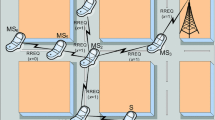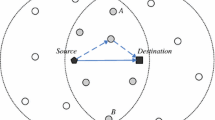Abstract
We consider infrastructure-based mobile networks that are assisted by a single relay transmission where both the downstream destination and relay nodes are mobile. Selecting the optimal transmission path for a destination node requires up-to-date link quality estimates of all relevant links. If the relay selection is based on link quality measurements, the number of links to update grows quadratically with the number of nodes, and measurements need to be updated frequently when nodes are mobile. In this paper, we consider a location-based relay selection scheme where link qualities are estimated from node positions; in the scenario of a node-based location system such as GPS, the location-based approach reduces signaling overhead, which in this case only grows linearly with the number of nodes. This paper studies these two relay selection approaches and investigates how they are affected with varying information update interval, node mobility, location inaccuracy, and inaccurate propagation model parameters. Our results show that location-based relay selection performs better than SNR-based relay selection at typical levels of location error when medium-scale fading can be neglected or accurately predicted.








Similar content being viewed by others
Notes
N−1 nodes overhear each link quality transmission. There are N−1 of such transmissions for each of the N hello message transmissions. In total N(N−1)2 receive events that can be aborted.
The ns-2 simulation is based on version 2.34.
References
Adam H, Elmenreich W, Bettstetter C, Senouci SM (2009) Core-mac: a mac-protocol for cooperative relaying in wireless networks. In: Global telecommunications conference, 2009. GLOBECOM 2009. IEEE. IEEE, pp 1–6
Angermann M, Robertson P (2012) Footslam: pedestrian simultaneous localization and mapping without exteroceptive sensors—hitchhiking on human perception and cognition. Proc IEEE 100(Special Centennial Issue):1840–1848
Bahl P, Chandra R, Lee PP, Misra V, Padhye J, Rubenstein D, Yu Y (2009) Opportunistic use of client repeaters to improve performance of wlans. IEEE/ACM Trans Netw (TON) 17(4):1160–1171
Bahl P, Padmanabhan V (2000) Radar: an in-building rf-based user location and tracking system. In: INFOCOM 2000. Nineteenth annual joint conference of the IEEE computer and communications societies. Proc. IEEE, vol 2. Ieee, pp 775–784
Durgin G, Rappaport T, Xu H (1998) Measurements and models for radio path loss and penetration loss inand around homes and trees at 5.85 GHz. 46(11)
Foxlin E. (2005) Pedestrian tracking with shoe-mounted inertial sensors. Comput Graph Appl IEEE 25 (6):38–46
Ghosh J, Beal M, Ngo H, Qiao C (2006) On profiling mobility and predicting locations of wireless users. In: Proceedings of the 2nd Int’l workshop on Multi-hop ad hoc networks: from theory to reality. ACM, pp 55–62
Hu Z, Tham CK (2010) Ccmac: coordinated cooperative mac for wireless lans. Comput Netw 54(4):618–630. doi:10.1016/j.comnet.2010.02.001. Advances in Wireless and Mobile Networks
(2007) IEEE: wireless LAN medium access control (MAC) and physical layer (PHY) specifications. IEEE Std 802.11-2007 (Revision of IEEE Std 802.11-1999):C1–1184
Khodjaev J, Hur S, Park Y (2012) Low complexity lts-based nlos error mitigation for localization. Ann Telecommun 67(9–10):471–476
Lassabe F, Charlet D, Canalda P, Chatonnay P, Spies F (2006) Predictive mobility models based on kth Markov models. In: IEEE international conference on pervasive services, pp 303–306
Liu JS, Wong YC (2004) A relay-based multirate protocol in infrastructure wireless lans. In: Networks. (ICON 2004). IEEE International Conference on Proceedings of 12th, vol 1, pp 201–206, DOI 10.1109/ICON.2004.1409124
Liu P, Nie C, Korakis T, Erkip E, Panwar SS, Verde F, Scaglione A (2012) Sticmac: a mac protocol for robust space-time coding in cooperative wireless lans. IEEE Trans Wirel Commun 11(4):1358–1369
Liu P, Tao Z, Narayanan S, Korakis T, Panwar S (2007) CoopMAC: a cooperative MAC for wireless LANs. IEEE J Sel Areas Commun 25(2):340
Lu M, Steenkiste P, Chen T (2009) Design, implementation and evaluation of an efficient opportunistic retransmission protocol. In: Proceedings of the 15th annual international conference on Mobile computing and networking. ACM, pp 73–84
Modsching M, Kramer R, ten Hagen K (2006) Field trial on gps accuracy in a medium size city: the influence of built-up. In: 3rd workshop on positioning, navigation and communication, pp 209–218
Navidi W, Camp T (2004) Stationary distributions for the random waypoint mobility model. IEEE Trans Mob Comput 3(1):99– 108
Nielsen J (2011) Location based network optimizations for mobile wireless networks—a study of the impact of mobility and inaccurate information. Ph.D. thesis, Aalborg University
Nielsen J, Amiot N, Madsen T (2013) Directional hidden markov model for indoor tracking of mobile users and realistic case study. In: Proceedings of the European wireless, 2013. EW. 19th European wireless conference. VDE Verlag GMBH
Nielsen JJ, Madsen TK, Schwefel HP (2010) Location-based mobile relay selection and impact of inaccurate path loss model parameters. In: Proceedings of the IEEE wireless communications and networking conference (WCNC)
Nielsen JJ, Madsen TK, Schwefel HP (2010) Location-based relay selection and power adaptation enabling simultaneous transmissions. In: Proceedings of the GLOBECOM workshops
Nielsen JJ, Madsen TK, Schwefel HP (2010) Mobility impact on centralized selection of mobile relays. In: Proceedings of the 6th IEEE consumer communications and networking conference - CCNC
Nielsen JJ, Olsen RL, Madsen TK, Schwefel HP (2012) On the impact of information delay on location-based relaying: a Markov modeling approach. In: Proceedings of the IEEE wireless communication and networking conference (WCNC)
Nielsen JJ, Olsen RL, Madsen TK, Schwefel HP (2013) Optimized policies for improving fairness of location-based relay selection. In: Vehicular technology conference (VTC Spring), 2013 IEEE 77th
Nielsen JJ, Olsen RL, Madsen TK, Uguen B, Schwefel HP (2012) Model-based evaluation of location-based relaying policies in a realistic mobile indoor scenario. In: Proceedings of computer aided modeling and design (CAMAD)
Nielsen JJ, Olsen RL, Madsen TK, Uguen B, Schwefel HP (2015) Location-quality-aware policy optimisation for relay selection in mobile networks. Wirel Netw:1–20. doi:10.1007/s11276-015-0986-0
Petzold J, Bagci F, Trumler W, Ungerer T (2006) Comparison of different methods for next location prediction. Euro-Par 2006 Parallel Process, pp 909–918
Proakis J (1995) Digital communications third edition. McGrawHill Inc, New York
Santos PM, Abrudan TE, Aguiar A, Barros J (2014) Impact of position errors on path loss model estimation for device-to-device channels. IEEE Trans Wirel Commun 13(5):2353– 2361
Selmi I, Samama N (2014) Indoor positioning with gps and glonass-like signals use of new codes and a repealite-based infrastructure in a typical museum building. Ann Telecommun 69(11–12):641–655
Shan H, Zhuang W, Wang Z (2009) Distributed cooperative mac for multihop wireless networks. IEEE Commun Mag 47(2):126–133
Touati S, Boujemaa H, Abed N (2015) Static hybrid multihop relaying and two hops hybrid relaying using dstc. Ann Telecommun 70(3–4):171–180
Wing MG, Eklund A, Kellogg LD (2005) Consumer-grade global positioning system (gps) accuracy and reliability. J For 103(4):169–173
Wymeersch H, Maranò S, Gifford WM, Win MZ (2012) A machine learning approach to ranging error mitigation for uwb localization. IEEE Trans Commun 60(6):1719–1728
Zhao B, Valenti M (2005) Practical relay networks: a generalization of hybrid-arq. IEEE J Sel Areas Commun 23(1):7–18
Zhu H, Cao G (2006) rDCF: a relay-enabled medium access control protocol for wireless ad hoc networks. IEEE Trans Mobile Comput:1201–1214
Zorzi M, Rao R (2004) Geographic random forwarding (GeRaF) for ad hoc and sensor networks: multihop performance. IEEE Trans Mob Comput 2(4):337–348
Author information
Authors and Affiliations
Corresponding author
Additional information
This work has been performed in the framework of the ICT projects ICT-217033 WHERE and ICT-248894 WHERE2, which are partly funded by the European Union.
The Telecommunications Research Center Vienna (FTW) has been supported by the Austrian Government and by the City of Vienna within the competence center program COMET.
Rights and permissions
About this article
Cite this article
Nielsen, J.J., Madsen, T.K. & Schwefel, HP. On the benefits of location-based relay selection in mobile wireless networks. Ann. Telecommun. 71, 211–222 (2016). https://doi.org/10.1007/s12243-015-0491-6
Received:
Accepted:
Published:
Issue Date:
DOI: https://doi.org/10.1007/s12243-015-0491-6




